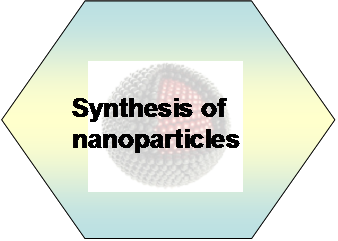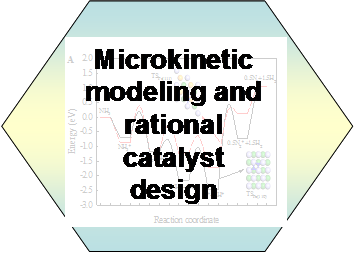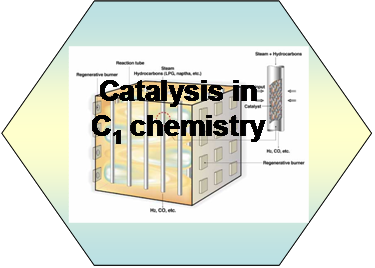Catalysis for new energy technologies
 The
catalyst properties can be manipulated by changing surface
compositions, sizes, shapes and morphologies of metal clusters. The
research in the group has been focused on synthesis of metal
clusters with different sizes, and shapes and core-shell
nanoparticles in a control manner. Surface reduction method was
developed to prepare the surface alloys. Hydratalcites have been
used as the catalyst precursors to prepare the nanoparticles
confined in cages to enhance the catalyst stability. Carbon
nanomaterials have been investigated as catalyst supports. The
core-shell structured Al2O3@CeO and ZrO oxides
were found to be very stable supports.
The
catalyst properties can be manipulated by changing surface
compositions, sizes, shapes and morphologies of metal clusters. The
research in the group has been focused on synthesis of metal
clusters with different sizes, and shapes and core-shell
nanoparticles in a control manner. Surface reduction method was
developed to prepare the surface alloys. Hydratalcites have been
used as the catalyst precursors to prepare the nanoparticles
confined in cages to enhance the catalyst stability. Carbon
nanomaterials have been investigated as catalyst supports. The
core-shell structured Al2O3@CeO and ZrO oxides
were found to be very stable supports.
 The
design and optimization of catalytic processes lies very much on the
detailed understanding of reactions at molecular level. Temperature
programmed desorption and surface reaction, steady-state isotopic
transient kinetic analysis, microcalorimetric measurements are
examples of the experimental investigations. The group has been
cooperated very closely with computational chemistry groups at NTNU,
MIT, East China University of Science and Technologies on first
principles study and reactive force field molecular dynamic
simulations, aiming at a better understanding of the relationship
between structure and catalytic performance.
The
design and optimization of catalytic processes lies very much on the
detailed understanding of reactions at molecular level. Temperature
programmed desorption and surface reaction, steady-state isotopic
transient kinetic analysis, microcalorimetric measurements are
examples of the experimental investigations. The group has been
cooperated very closely with computational chemistry groups at NTNU,
MIT, East China University of Science and Technologies on first
principles study and reactive force field molecular dynamic
simulations, aiming at a better understanding of the relationship
between structure and catalytic performance.
 Kinetic
study, in particular the transient kinetic study is a powerful tool
for understanding of the surface reactions. Tapered Element
Oscillating Microbalance (TEOM) was applied to study the adsorption
and diffusion of hydrocarbon in zeolites both at inert and reaction
conditions. The TEOM reactor has also been applied to the kinetic
study of coke/carbon deposition and deactivation. The steady-state
isotopic transient kinetic analysis and in-situ UV-Vis spectroscopic
study have been applied in kinetic study.
Kinetic
study, in particular the transient kinetic study is a powerful tool
for understanding of the surface reactions. Tapered Element
Oscillating Microbalance (TEOM) was applied to study the adsorption
and diffusion of hydrocarbon in zeolites both at inert and reaction
conditions. The TEOM reactor has also been applied to the kinetic
study of coke/carbon deposition and deactivation. The steady-state
isotopic transient kinetic analysis and in-situ UV-Vis spectroscopic
study have been applied in kinetic study.
 Microkinetic
modeling based on elementary reaction steps on the surface is a
powerful tool, where the kinetic parameters are estimated based on
the first principles or other theoretic methods like transition
state theory. Microkinetic models have been developed for methane
reforming on Ni catalyst, F-T reaction on Co catalyst, conversion of
light paraffins on Pt catalyst, C4 dimerization on
zeolite catalyst. The microkinetic model has been extended for
rational catalyst design.
Microkinetic
modeling based on elementary reaction steps on the surface is a
powerful tool, where the kinetic parameters are estimated based on
the first principles or other theoretic methods like transition
state theory. Microkinetic models have been developed for methane
reforming on Ni catalyst, F-T reaction on Co catalyst, conversion of
light paraffins on Pt catalyst, C4 dimerization on
zeolite catalyst. The microkinetic model has been extended for
rational catalyst design.
 Gas
to liquids including synthesis gas production by steam and dry
methane reforming, partial oxidation and chemical looping partial
oxidation, as well as Fischer-Tropsch synthesis is the main reaction
topic of the group. The research covers also the ethane and propane
dehydrogenation and oxidative dehydrogenation, ethylene
oxychlorination and water gas shift reaction
Gas
to liquids including synthesis gas production by steam and dry
methane reforming, partial oxidation and chemical looping partial
oxidation, as well as Fischer-Tropsch synthesis is the main reaction
topic of the group. The research covers also the ethane and propane
dehydrogenation and oxidative dehydrogenation, ethylene
oxychlorination and water gas shift reaction
 The
research addresses the fundamental understanding of the relationship
between catalyst properties and selective activation of C-O, C-H,
C-C and O-H bonds, which is essential to control the selectivity in
biomass conversion. The research topics are conversion of biomass
derived oxygenates to hydrogen and fuels by means of aldol
condensation reactions.
The
research addresses the fundamental understanding of the relationship
between catalyst properties and selective activation of C-O, C-H,
C-C and O-H bonds, which is essential to control the selectivity in
biomass conversion. The research topics are conversion of biomass
derived oxygenates to hydrogen and fuels by means of aldol
condensation reactions.
